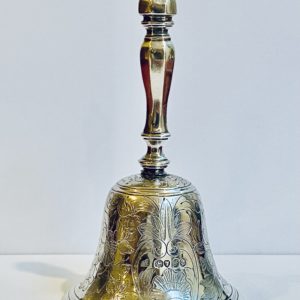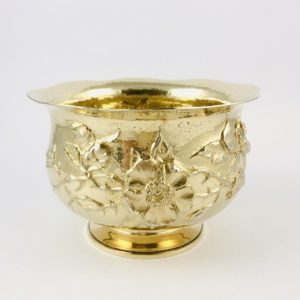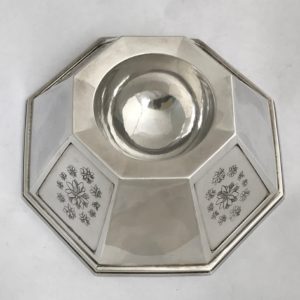Description
An attractive and characteristically shaped sterling silver Masonic jewel in the form of a flat plumb engraved on both sides with a central vertical reference line at the base of which is a tear-drop shaped piercing to represent the bob. The attractively shaped, reeded edges of the piece are engraved with a broad and a narrow line exactly following the contours of the edge.
At the top of the jewel is a silver hanger, allowing suspension from a collar, taking the form of an articulated, omega-shaped ring attached to the jewel by a short, circular, bifurcated stem.
The jewel is made of a good gauge of silver with a matt finish.
Significance of the shape:
A plumb is a tool that is the vertical equivalent of a level. Usually fashioned out of wood or metal with a string and weight attached, it has been used by stonemasons for thousands of years to ensure that structures stand straight. The string is fixed at the point to be plumbed, and the weight, or bob, is then allowed to swing freely. When the weight stops, the point of the bob is precisely below the point at which the string is fixed above. As Freemasonry emerged, this emblem of a builder’s Craft transformed into a powerful symbolic instrument to teach moral lessons. A Freemason first encounters the plumb in the second degree as one of the working tools of a Fellowcraft. The operational use of the plumb line was primarily to make sure that a wall was straight up and down. As a physical tool, it represents strict adherence to standards, leaving no room for deviation in the construction of a building. Its conceptual use in the Craft is to serve as a guiding principle that helps Brethren stay true to Masonic values regardless of circumstance. The plumb symbolizes commitment to justice and integrity, the continual pursuit of truth, and balancing ambition with humility.
Hallmarks:
The item carries the appropriate control marks for Sterling Silver (Lion Passant Guardant), the king’s head duty mark (George III), with a date letter “I” appropriate to the year 1804-5. However, the king’s head duty mark shows a small notch at the bottom of the punch, narrowing the period in which the item was assayed to between 11 Oct 1804 and 28 May 1805. It lacks the Crowned Leopard’s Head mark, showing that it was assayed in London, because it is classed as a small item and did not require it.
The maker’s mark, of Roman capitals “TH” in a rectangular punch, is for Thomas Harper of Fleet Street in London, the most eminent and prolific masonic jeweller in the late eighteenth and early nineteenth centuries. (His trade card, from the Heal Collection in the British Library, shows masonic symbology, including a plumb – see picture).
Dimensions & Weight:
Height (including suspension ring): 9.5 cm / 3 ¾ ins. Width 10.5 cm / 4 1/8 ins. Weight: 33 gms. / 1.0 ozT.
Masonic Jewels
Masonic jewels can be classified[1] in several different ways. Leaving aside commemorative or specially granted jewels, a fundamental distinction is between Lodge jewels, which belong to the Lodges concerned, and personal jewels, the property of individual members. The other main distinction is between collar jewels, worn suspended from a collar, and breast jewels, worn in the manner of a medal. Jewels may also be classified by the method of manufacture as pierced, cast or plate. This item is a collar jewel of engraved plate type.
[1] Timothy Kent, Thomas Harper, Masonic jeweller and the jewels of his period, in Silver Studies, the Journal of the Silver Society, No. 19, 2005, p. 14.







